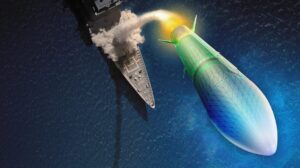The Missile Defense Agency (MDA) is preparing to shift its hypersonic missile defense effort analysis to hardware development after final reviews, the director said recently.
The program, called Glide Phase Interceptor (GPI), is currently in its analysis phase with Raytheon Technologies
[RTX] and Northrop Grumman [NOC].
“They’re really delivering on high fidelity models, we gave them a really tough threat set. It’s an expanded threat set well beyond sea-based terminal [defense] that takes on some of those acute and…pacing threats, China and Russia. So we’re building against that,” MDA Director Vice Adm. Jon Hill said during a Center for Strategic and International Studies (CSIS) event on Friday.

Hill said DoD is preparing to transition to technology development next.
“We had a really great risk review conducted by the [Under Secretary of Defense for Research and Engineering]. It’s called an ITRA, the technical risk assessment. And we also have the [Cost Assessment and Program Evaluation] analysis that has taken a look at where the budget is. And so we’re addressing that in this next phase that we’ll pivot to here shortly.”
Hill said MDA is preparing to go to a Joint Requirements and Oversight Council meeting this week and then a review with the Missile Defense Executive Board. “After that, we’ll transition over to that hard technical development. And so that’s when you start to get into real hardware components and those sorts of things to fly in that environment.”
He noted the agency will still continue working on science and technology for GPI to make sure it can operate in glide phase due to the wide differences between defending in the phase versus dealing with ballistic missiles in space.
“Operating in space is different than operating down low in the atmosphere, different when you’re on the edge of the atmosphere where these things glide.
Hill said MDA plans to deploy GPI first to naval vessels at sea “and then we’re also in parallel looking at what we can do for forward deployed air bases and Army maneuver force.”
MDA first awarded contracts to Raytheon, Northrop Grumman and Lockheed Martin [LMT] to develop and refine their respective concepts for a Glide Phase Interceptor (GPI) hypersonic missile defense system in 2021 (Defense Daily, Nov. 22, 2021).
Then in 2022 MDA downselected to only Raytheon and Northrop Grumman to continue refining their concepts (Defense Daily, June 24, 2022).
At CSIS, Hill said MDA conducted the downselect “very early in the concept piece because if you have a set of requirements, and they’re not being met, well, then that’s the criteria for down-selecting to two. So we’re with two today on the Glide Phase Intercept program for hypersonic defense. And we’ll carry those two and then we’ll get to a preliminary design review.”
Hill said the current GPI acquisition plan calls for another downselect to one vendor after the preliminary design review is completed.
However, Hill said the strategy does not foreclose the possibility the Defense Department will decide to shift to a strategy more like the Next Generation Interceptor (NGI) for the Ground-based Midcourse Defense system, which is carrying two vendors with firm development contracts at least through the critical design review phase (CDR).
He noted the programs are at different stages of maturity, but higher up officials could change the plan if more NGIs or GPIs are wanted faster.
“It could be that [Under Secretary of Defense for Acquisition and Sustainment William LaPlante] and others in the building want us to carry two and have dual production lines in the world that we’re in, I don’t know yet. But right now, the acquisition strategy on Next Generation Interceptor, for ground base, has us downselecting it at CDR to currently add to the inventory. It’s about adding to the inventory. You could say I want to replace older inventories, lots of flexibility there,” Hill said.
Earlier this month, Hill laid out how DoD is exploring the possibility of cooperatively developing and producing GPI hypersonic defenses, comparing it to the current cooperative development Standard Missile-3 Block IIA (Defense Daily, March 16).